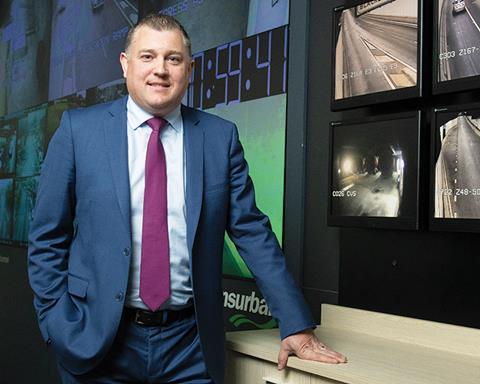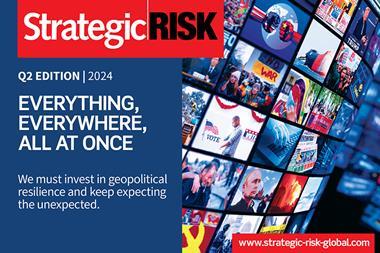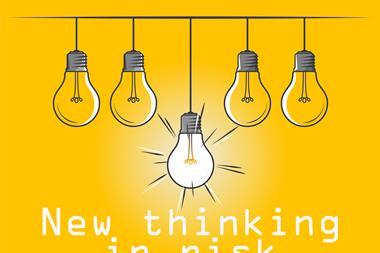Transurban’s troubleshooting guru Karl Davey exudes an air of calm and flexibility that helps him navigate all of risk’s diversions. With him at the helm, we’re all a little safer.
Did you know that in your lifetime you are five times more likely to die being struck by lightning than drowning in a flooded tunnel? Those seemed like terrific odds until arriving at the Cross City Tunnel offices, home to Transurban, during what can only be described as a cataclysmic winter storm. Black skies, biblical rain and winds so wild the trees are bent sideways. Standing waiting calmly in reception is Transurban’s head of risk, Karl Davey, who smiles and waves.
It is this calmness in the face of chaos that Davey is best known for and it’s a quality that will continue to emanate throughout our conversation.
Working as a risk manager on some of the US and Australia’s busiest arterial roads must be unnerving but it is a job that Davey has taken to like a fish to water since he took on the role in March 2015. In fact, Davey says he has long been a risk manager at heart, having gotten his first taste at university.
“I was doing electronic engineering and computer design at university. I did a placement with a bit of software design and electronics, and while I was there, they said: ‘We do this project management discipline called risk management. It involves helping our decision making, looking at things that can go wrong, looking for opportunities to do things differently.’ I got involved in some workshops, including major telecommunications projects and defence contracts, and I was sold. It was brilliant,” he says.
The path to risk
What really sold Davey on the discipline of risk management, he says, is being a “troubleshooting guru”. “It is about getting someone in the business to explain what they’re doing and having a conversation around what could stop them from achieving what they need to do, as well as what you need to do and how you can make that decision together.”
“Those early days in my career really showed how formalising a process of decision making and risk management can help support an outcome. I could see how projects were struggling, how to take a step back, look at their environment and then start to come in at an earlier point to help. It was a great insight to risk in those days.”
Davey says the key to achieving goals for the business within a comfortable risk parameter is acquiescence. “The thing that I’ve learned from day one is you have to be agile. If you go in with a preconceived idea of how you’re going to do something and you’re not prepared to deviate, probably 90% of the time you’re not going to get the outcomes that you need. You have to be flexible.”
“You have to align your approach to the maturity and the needs of the business, and the audience that you’re working with. Risk can be quite simplistic for some people, or you could be going into detailed quants and numbers and decision trees or quantitative analysis with another group of people.”
“I think it comes down to the lens that needs to be applied to the conversation and the work that you’re doing. You see it all too many times, articles on LinkedIn where people are saying: ‘Risk doesn’t work.’ I think people have forgotten what the fundamentals of risk management are. It’s about refreshing ourselves with the approaches and techniques that we use and not being afraid to vary those into something that fits with the business understanding and the operating environment that you’re working within.”
Use your mirrors
Listening to Davey speak with such firm-footed surety in his hybrid British-Australian accent makes it easy to forget we are chatting in a bustling control room, surrounded by countless monitors whose eagle eyes guard the arteries deep beneath Sydney.
When asked how he manages the prospect of getting tens of thousands of drivers and vehicles safely to their destinations, through rain, hail and shine, Davey nods towards the myriad of monitors and says: “There are two sides to managing this risk. We work with governments and other organisations to put in place campaigns to increase awareness on things such as road signs.
“We also look to challenge the way our assets are designed and laid out, so we can try to encourage positive behaviours in the way they are used,” he says. “When you look at what risk is to us within the team, it’s about preventing things from going wrong, but then also within the team, we’ve got emergency management and business continuity – looking at the things that can happen and their implications.”
The tools Davey uses to assist him in his job are not groundbreaking, but the way in which he uses them may well be. “The backbone of it all is we have our common enterprise risk management and systematic risk management. Depending on the audience, it’s the lenses that we need to use if we’re involved in an acquisition or business planning, or putting proposals together for a project. We may be doing quantitative analysis on cost and schedule for budgets.”
Davey says being agile enough to switch tools is imperative in the types of high-risk situations occurring on motorways and in tunnels. “We have all the safety systems that we use to help us with instant risk management, hazard analysis and similar types of techniques. Scenario analysis tools, brainstorming, issuing diagrams, all those types of things. Ultimately, it is just using the right tool with the audience.”
“I’ve often said with risk workshops, you can’t go in with a preconceived idea of what tool you’re going to use. It is likely within a few minutes of having that conversation, you can delve into your bag of tools to find the most appropriate one to navigate the discussion and adds value to the audience.”
What’s in the safety toolbox?
Next, we discuss what role technology plays in managing the Transurban ‘assets’, as Davey refers to them. Not only is technology valuable to the organisation when focusing on risk but the organisation itself continually challenges its methodologies and conclusions on risk via technology, he says.
“The technology we use is always changing. We are always looking for improvements. Recently we’ve put in a variable speed limit. Now we’re detecting traffic flow, traffic movements, weather conditions and we can change the speeds in the tunnel. Interestingly, by slowing people down, it means they get to their destination faster because we even out the traffic flow.”
Selective use of technology and social media is a crucial tool in Davey’s toolbox of safety. “People rely on what we do, and they don’t want us disrupting their lifestyle. We are big on social media where possible, but we remain limited with some of the things we can do. It depends on the arrangement you have with the government or transportation body. There are always requirements about who is the notification agency, but certainly, we do anything that we can to communicate efficiently.”
Disruption is where our conversation heads to next, with Davey joking it is the last thing he wants in a traffic-ridden tunnel. Jokes aside, he says disruption of the business is a natural by-product of agility. “We are the kind of company that seeks to try to disrupt ourselves. It’s an ever-changing environment out there. We have to look after the safety of our workers, the safety of the people you can see driving down the road today in this horrible weather, and the safety of those people around our assets. A wet day can change that operating environment, so we have to be very dynamic in our job concerning what we do from a risk perspective.
“It is about thinking about what we face, challenging the norms, and how we can do things differently. When you bring all of that together, it makes it quite an interesting environment to be looking at risks. It’s not just our risk; it’s the risk of all of these people’s lives out there.”

Car trouble
One disruptive risk set to challenge Davey in the coming years is the rise of autonomous vehicles, and it isn’t something he is taking lightly. “Everyone’s always looking into what’s next, how we can keep people moving, what are the opportunities. We’re doing a trial at the moment that is looking at the different levels of autonomy in road cars that are available today and doing pilots to see how they react to our assets. Can the cameras in the cars understand what the signs mean in the tunnels? How do they react driving in tunnels with their sensors?
“As those cars become more and more commonplace in the next generation, I think they’re a great opportunity for us to embrace how our roads are used. Our business is trying to disrupt itself thinking about those risks and opportunities and putting that into place within the business.”
Distracted drivers are one of the most dangerous things about driving today and a challenge that Davey faces daily. Mobile phones with texts and calls coming in, changing music playlists, screaming kids in car seats, air-conditioning on-off-on again. If even one of these means a driver takes their eyes off the road for a second, it can spell disaster.
Balancing the risk of keeping motorists safe and moving by making sure they are aware of what is occurring ahead in the tunnel but not distracting them is a significant challenge, says Davey.
“Usually, if someone has an accident or breakdown in one of our assets, the radio will cut in and say: ‘Please stay out of the outside lane. We have a response vehicle coming through so we can get to the incident as quickly and as safely as possible, so that you can be on your way safely as quickly as possible.’”
“We’re trying to make it safer for everyone. However, it is about finding that risk balance. Am I distracting you by giving you too much information about what is happening up ahead? We always have to think about counterpoints to arguments and discussions. It is extremely challenging but that’s where scenarios come into play.”
Getting you there
Davey’s affability makes him a great asset to Transurban and the risk community. The way he speaks about his work gives you the impression it has become second nature to him and it shows that he seems to genuinely care about the occupants of every vehicle on the road. “I mean it when I say safety is our key priority; making sure of what we’re doing to manage those risks around the security of our workers, as well as the users of roads.”
For Davey, getting motorists to their destinations on time is almost as important as getting them there safely. “We have closures where we do works overnight, and it is imperative that we open the road safely and on time for people as well. The last thing you want when you’ve got that early start to the airport is to come along and find the roads closed because of something we haven’t done.”
“My ‘2 a.m. phone call’ would be around those types of subjects. Key risks materialising. A lot of this stuff will be articulated through our risk appetite, regarding what the business is prepared to accept and not accept. The things we’ve got zero tolerance for is the stuff that keeps me up at night, making sure that I’m managing those risks around there. It’s about using risk management to support correct decisions that lead to the outcomes that we want.”
As our morning draws to a close, he reflects on what is unique about being a risk manager in Australia. “We are fortunate in Australia that risk is talked about openly and frequently but I still think there are varying degrees of maturity concerning the practice.”
“Having experience of risk in Europe and the States, some techniques are a little more commonplace, such as the use of quantitative analysis beyond projects regarding cost and schedule. It certainly seems to be more utilised in those regions, based on my experience of what I used to get asked for over there, and some of my time here in Australia.”
Davey calls on Australian risk managers not to sit on their laurels but instead keep striving for better. “We’ve had some boons, and of course we’ve had some busts. Making sure that risk is on people’s radar and part of their decision making in the good times when you think you can do no wrong is just as important as when you start to see the operating environment change. We always have to be challenging ourselves and not just accepting the good times.”
Drive safely, Sydney – Karl Davey is watching out for you.





















No comments yet